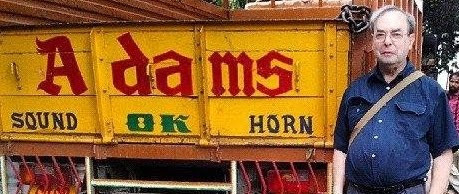The
double-headed eagle, national symbol of Albania[i], has an ancient ancestry.
Its earliest known manifestation is amongst artefacts dating back to Ancient
Babylon, 2000-3000 years BC[ii].
Recently,
I was walking along London’s Fleet Street when I happened to notice a building
with a double-headed eagle above its main entrance. This building houses the
private bank C Hoare and Co. The bank, founded in 1672, has had premises on
this site since 1690, when its founder Richard Hoare moved his business there
from “The Sign of The Golden Bottle” on Cheapside[iii]. The golden bottle is
the bank’s emblem; the double-headed eagle is that of the Hoare family.
[i] And many other places!
[ii] See for example The Art and Architecture of the Ancient Orient by H Frankfort, (4th ed.) publ. by Penguin Books, Harmondsworth: 1970.
[iii] Historical information about the bank comes from Hoares Bank – A Brief History, published by the bank as a four page handout. I was given a copy of this by the doorman, who shared my interest in the double-headed eagle.
The
founder of the Hoare (or Hore) family was Robertus who, in about 1330, married
an heiress of the family of Fforde of Chagford in the county of Devon[i]. Earler than that, there
was a Sir William le Hore, who besieged and captured the Irish town of Wexford
in 1169. His standard[ii] bore a double-headed
eagle[iii]. One of his descendants,
went over to Devonshire in England to seek his fortune and married the heiress
of Fforde. He settled at Chagford and founded the Devon family which was at
first known as ‘Hore’ and later as ‘Hoar’ or ‘Hoare’. Other branchs of the
family settled in the South east quarter of Devonshire. This family has its
armorial insignia described in the record of the earliest visitation of
Devonshire as ‘Sable an eagle displayed with two necks within a bordure
engrailed argent’. The London bank, whose premises are in Fleet Street, was
founded by member(s) of this Hoare family.
I wonder why the curious heraldic device of the double-headed
eagle was adopted by this family. From what I have already written, it is
evident that the family was employing it in the 12th century,
certainly by 1169. This was before 1256 when Richard, Earl of Cornwall, was
elected to become King of the Holy Roman Empire, one of whose most well-known
emblems is the double-headed eagle. So, it is unlikely that the family picked
up the double-headed eagle from that source.
The eagle with two heads was
certainly used by the Byzantine Empire and also the Seljuk Turks. It has been
claimed by some that people returning from the Crusades, which began in the
late 11th century, may have brought this symbol to Western Europe.
However, there is evidence that it reached this part of the world even earlier.
Emile Male wrote that there is a cloth dating back to the 9th or 10th
century AD at Sens in France[iv]. Although he believed it
to have been of Byzantine origin, I suggest that the presence of it and other
similarly decorated textiles in Western Europe may have helped to have brought
the double-headed eagle to the attention of those living in France, many parts
of which were under control of the Normans who were also ruling England.
[i] The history of the Hoare family, which I have consulted, is that written by Edward Hoare. It appears in http://neergaard.org/CGTGenealogy/Family%20Histories/Family%20Histories-%20Crests/History%20of%20Hoare%20Family.html, which I accessed on the 19th May, 2015.
[ii] i.e. flag or crest.
[iii] See also: A General Armory of England, Scotland, and Ireland, by J & JB Burke, publ. by Edward Churton, London: 1842.
[iv] See: L’art Religieux du XIIe Siecle, by E Male, publ. by Librairie Armand Colin, Paris: 1922.
When I told the porter of the Hoare Bank in Fleet Street about my interest in double-headed
eagles, he told me that he had often wondered about the curious eagle above the
door where he stands all day. His view was that the Hoare family chose to use
the double-headed eagle sometime after the bank was founded simply because
nobody else was using this heraldic symbol[i]. As I hope that I have
demonstrated, the use of this symbol by the Hoare family goes back much further
than the founding of the bank. Lastly, I must point out that I have a tenuous
connection with Hoare’s bank. Some years ago, my wife used to work for an
offshoot of this venerable bank.
[i] The double-headed eagle is usel
rarely in British heraldry. Most of the families that use it come from the West
Country, which includes Devon and Cornwall.
Explore Adam Yamey's writing by visiting:








No comments:
Post a Comment
Useful comments and suggestions are welcome!